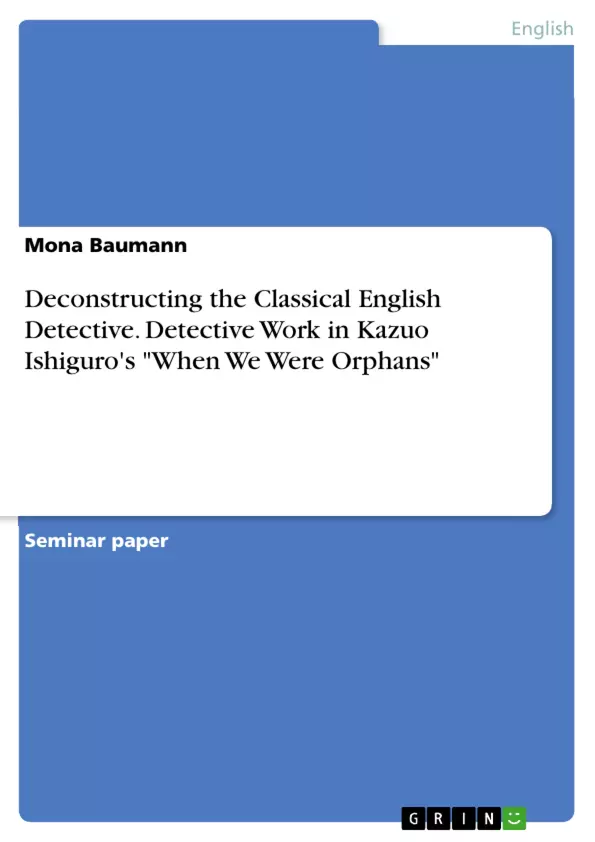This paper describes Kazui Ishiguro's Detective Christopher Banks and compares him to Arthur Conan Doyle's Sherlock Holmes.
Crime fiction is one of the most successful, extensive and international genres of the late twentieth and the early twenty-first century. Detective fiction is very versatile, consisting of the whodunit, thriller, private eye and hard-boiled, just to name a few subgenres. In a detective story, the reader expects a crime as well as doubt about motive, means and perpetrator, provided with a fair trail of clues to investigate and solve the crime.
Nineteenth-century detective fiction shed a light on the British Empire in a destabilising whilst at the same time reassuring way for national readers. England’s aggressive authority and force were considered a frequent method of maintaining social control and were therefore often addressed by late-eighteenth and early-nineteenth-century writers. Detective stories were able to turn such obsolete aggression into a more contemporary, benign authority by offering detection as a possibility to avoid despotic representations of government authority.
Modern British detective fiction tends to include transcultural perspectives. Today, writers use a variety of topics, sometimes even combined with ancient myths or tales in order to attract more readers at home and abroad. The British author Elly Griffiths, for example, set the plot of her novel Smoke and Mirrors in Brighton in 1951, where the bodies of two missing children, dubbed by the newspapers as ‘Hansel and Gretel’, were found, giving the story a fairy-tale touch.
The Nobel Prize winning writer Kazuo Ishiguro also went back in time for his novel "When We Were Orphans". The author might not be the first coming to mind when thinking about detective fiction. In his novels, Ishiguro explores the topic of cultural identity.
The novel is full of allusions to Sherlock Holmes. Small details and objects remind the reader of the iconic investigator and even characters in the book compare Holmes and Banks, who is impressed by Doyle’s mysteries. As Barry Lewis claims, Ishiguro’s protagonist may be investigating his past life “with Holmes-like meticulousness”. Nevertheless, When We Were Orphans does not describe a detective as depicted in Doyle’s Sherlock Holmes Stories. In Ishiguro’s novel, the structure of the story, the detective’s associates and the detective’s character are presented differently and not in a Holmesian way.
Inhaltsverzeichnis (Table of Contents)
- Introduction
- History and Transculturality of Detective Fiction
- A Comparison of When We Were Orphans with Arthur Conan Doyle's Stories
- Story Structure and Methodology of Investigation
- Supporting Characters
- Character Traits of the Protagonists
- Conclusion
Zielsetzung und Themenschwerpunkte (Objectives and Key Themes)
This text aims to explore the transcultural aspects of detective fiction, specifically comparing Kazuo Ishiguro's "When We Were Orphans" to the works of Arthur Conan Doyle. The text delves into the evolution of the detective genre, tracing its roots from ancient narratives to modern adaptations.
- The historical development of detective fiction
- Transcultural perspectives in modern detective fiction
- Comparison of detective methods and characterization in "When We Were Orphans" and Sherlock Holmes stories
- The influence of cultural context on crime fiction
- The role of science and investigation in detective narratives
Zusammenfassung der Kapitel (Chapter Summaries)
- Introduction: Introduces the detective genre, its subgenres, and its significance in contemporary literature. It explores the historical context of British detective fiction, emphasizing its role in reflecting national identity and societal concerns.
- History and Transculturality of Detective Fiction: Traces the origins of detective fiction from biblical narratives to Shakespearean tragedies, highlighting its evolving nature and cultural influences. It discusses the contributions of prominent authors like Edgar Allan Poe and Charles Dickens. The chapter emphasizes the integration of scientific advances and the emergence of distinct national subgenres.
- A Comparison of When We Were Orphans with Arthur Conan Doyle's Stories: This chapter analyzes the similarities and differences between Ishiguro's novel and Doyle's Sherlock Holmes stories. It focuses on the structure of the narratives, the portrayal of supporting characters, and the distinctive traits of the protagonists.
Schlüsselwörter (Keywords)
This text explores the transcultural aspects of detective fiction, focusing on the works of Kazuo Ishiguro and Arthur Conan Doyle. Key terms include detective fiction, transculturality, cultural identity, crime fiction, Sherlock Holmes, "When We Were Orphans," whodunit, hard-boiled, and scientific investigation. The text delves into the history and evolution of the genre, exploring the impact of social, political, and scientific developments.
- Quote paper
- Mona Baumann (Author), 2018, Deconstructing the Classical English Detective. Detective Work in Kazuo Ishiguro's "When We Were Orphans", Munich, GRIN Verlag, https://www.grin.com/document/424749



